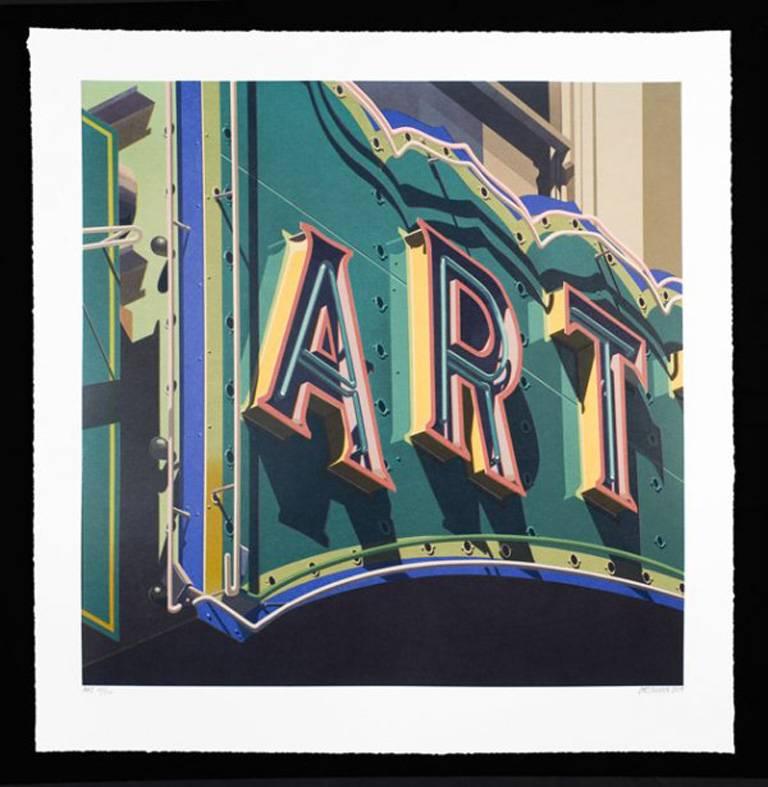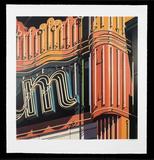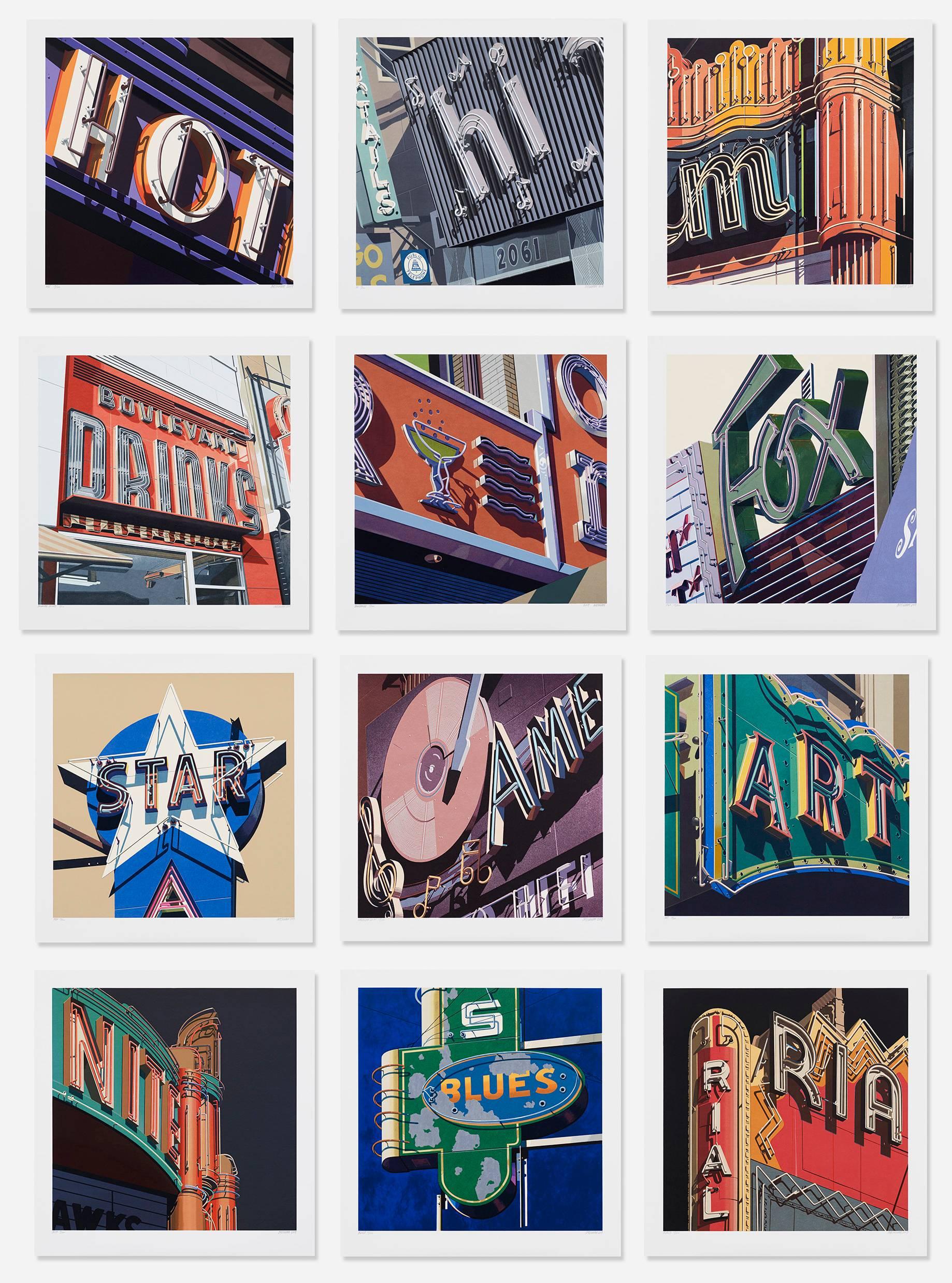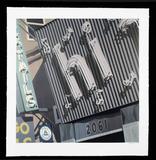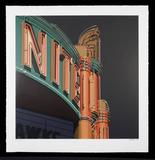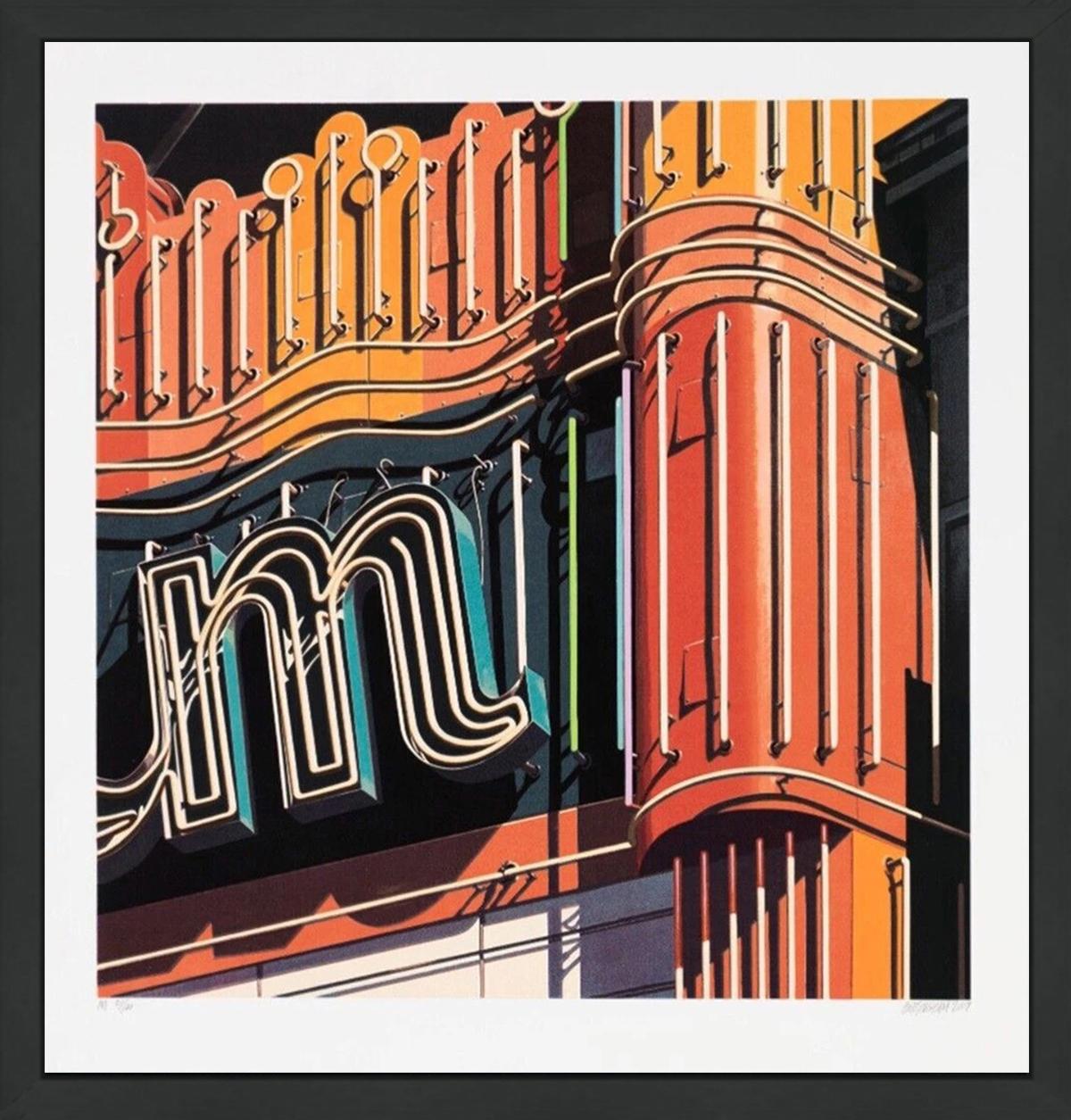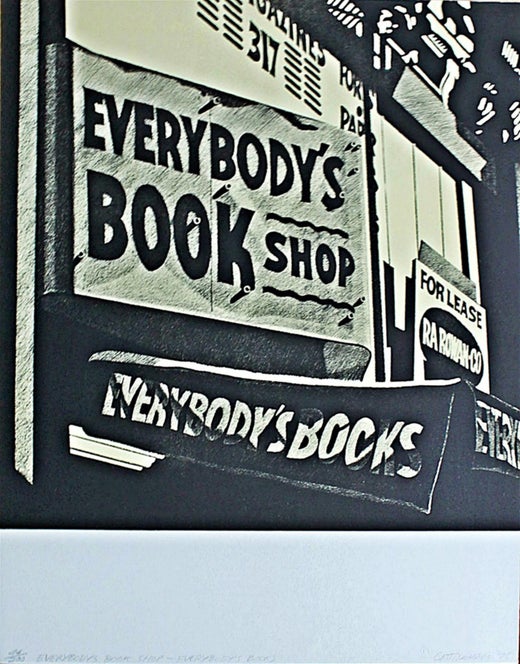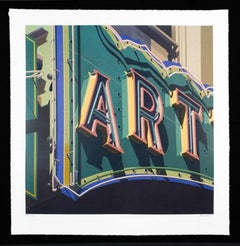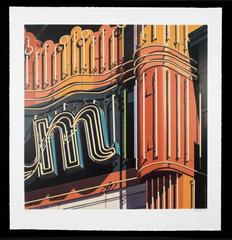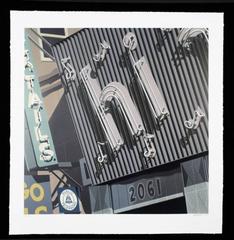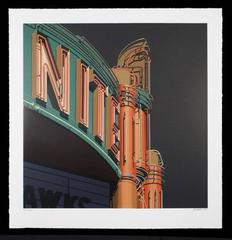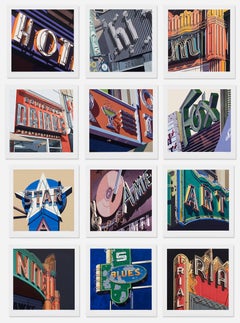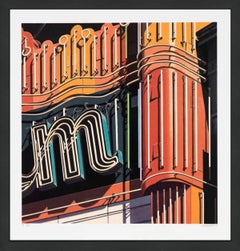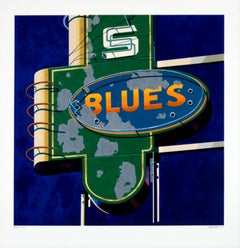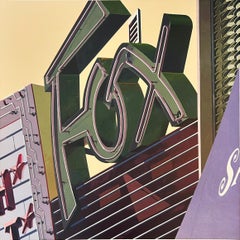Items Similar to Hot, from American Signs Portfolio
Want more images or videos?
Request additional images or videos from the seller
1 of 8
Robert CottinghamHot, from American Signs Portfolio2009
2009
Price Upon Request
Price Upon Request
Price Upon Request
Price Upon Request
Price Upon Request
Price Upon Request
Price Upon Request
Price Upon Request
Price Upon Request
Price Upon Request
About the Item
ROBERT COTTINGHAM
Hot, from American Signs Portfolio, 2009
screenprint in colors, on wove paper, with full margins
40 1/8 x 39 1/8 in (101.9 x 99.4 cm)
signed, dated `2009' and numbered edition of 100 in pencil
--
Robert Cottingham
B. 1935, BROOKLYN, NEW YORK
Born in 1935 in Brooklyn, Robert Cottingham is known for his paintings and prints of urban American landscapes, particularly building facades, neon signs, movie marquees, and shop fronts. After serving in the U.S. Army from 1955 through 1958, he earned a BFA at Pratt Institute, Brooklyn, in 1963. Cottingham began his professional artistic career as an art director for the advertising firm Young and Rubicam in the early 1960s. Although he is typically associated with Photorealism, Cottingham never considered himself a Photorealist, but rather a realist painter working in a long tradition of American vernacular scenes. In this respect, his work often draws parallels to a number of American painters such as Stuart Davis, Charles Demuth, Edward Hopper, and Charles Sheeler.
Cottingham’s interest in the intersections of art and commerce derive from his career as an adman and the influence of Pop art. Many of his paintings convey an interest in typography and lettering, as well as an awareness of the psychological impact of certain isolated words and letters. In his facades, techniques from advertising, namely cropping and enlarging, often produce words of enigmatic or comical resonance such as “Art,” “Ha,” or “Oh.” Cottingham’s enlarged sense of scale is reminiscent of James Rosenquist’s work, while his interest in text suggests the influence of Robert Indiana and Jasper Johns. In general, Cottingham viewed his work as continuing the legacy of Pop artists such as Andy Warhol, who also had a background in advertising.
In 1964, Cottingham relocated to Los Angeles for work. There, inspired by the drastically different environment of the West Coast metropolis, he began to commit seriously to painting. Fascinated by Hollywood’s exaggerated glitz and the downtrodden atmosphere of the downtown, Cottingham saw in Los Angeles the relics of a bygone commercial heyday and desired to capture its kitschy and uncanny atmosphere, bathed in the near perpetual sunlight of Southern California.
In 1968, Cottingham ended his advertising career in order to devote all his time to painting. In the late 1960s, he started using photography in his practice, first as an initial reference point for his process. After selecting a photograph, he translates it into black-and-white drawings by projecting the image onto gridded paper, as a means of perfecting the tonal range between light and shadow. He often creates subsequent studies on paper using color. He finalizes the process by projecting either the original slide or any of the drawings onto a canvas and organizing the composition according to a grid. Another reason for Cottingham’s rejection of the Photorealist label is that he does not view his works as mere painterly translations of photographs or reproductions of reality. He has been known to change the words in his facades to alter the meaning of the subject. His primary interest lies in the subject matter—the urban American vernacular—rather than the deployment of a photo-based technique. After spending a period of time in London from 1972 to 1976, Cottingham found the city’s signs and history too foreign and removed from his own interests, and returned to the United States to settle in rural Connecticut. During the late 1970s and 1980s, his urban cityscapes became more expansive, with more complex and broader views of storefronts, vistas, and entire neighborhoods. In the late 1980s and early 1990s, Cottingham expanded his iconography of American vernacular culture to include trains and railroad imagery. More recently, he has focused on images of vintage typewriters, a subject that first interested him in the late 1990s.
Cottingham taught at the Art Center College of Design, Los Angeles (1969–70), and the National Academy of Design, New York (1991). He was the artist in residence at Wesleyan University, Middletown, Connecticut (1987–92). His work has been included in significant group exhibitions, including Documenta, Kassel, West Germany (1972), and those at the Serpentine Gallery, London (1973); Centre national d’art contemporain, Paris (1974); Whitney Museum of American Art, New York (1978); a traveling exhibition at the National Museum of American Art (now Smithsonian American Art Museum), Washington, D.C. (1986); Samsung Museum of Modern Art, Seoul (2001); and Deutsche Guggenheim, Berlin (2009). Cottingham’s printed oeuvre was celebrated by a solo presentation at National Museum of American Art in 1998–99. The artist lives and works in western Connecticut.
- Creator:Robert Cottingham (1935, American)
- Creation Year:2009
- Dimensions:Height: 40 in (101.6 cm)Width: 39 in (99.06 cm)
- Medium:
- Movement & Style:
- Period:
- Condition:Full suite of 12 prints from American Signs portfolio available.
- Gallery Location:New York, NY
- Reference Number:1stDibs: LU3261217693
Robert Cottingham
Robert Cottingham is an American painter best known for his Photorealist depictions of cropped commercial signage. Born on September 26, 1935, in Brooklyn, NY, Cottingham studied at Pratt Institute. He received his BFA in 1963 before starting a five-year career in commercial advertising. Upon moving to Los Angeles, Cottingham seriously committed himself to his painting practice, which eventually subsumed his advertising career by 1968 as the artist rose to prominence along with the Photorealist movement. Notably—though Cottingham is considered among the most prominent Photorealists of the latter half of the 20th century—he disavowed his relationship to the movement. Instead, he views his work as part of the lineage of vernacular Americana painters, including the likes of Stuart Davis and Edward Hopper. His work can be found in The Metropolitan Museum of Art collections in New York and the Smithsonian American Art Museum in Washington, D.C., among others.
About the Seller
5.0
Gold Seller
Premium sellers maintaining a 4.3+ rating and 24-hour response times
Established in 1996
1stDibs seller since 2013
743 sales on 1stDibs
Typical response time: 1 hour
- ShippingRetrieving quote...Shipping from: New York, NY
- Return Policy
More From This Seller
View AllArt, from American Signs portfolio
By Robert Cottingham
Located in New York, NY
ROBERT COTTINGHAM
Art, from American Signs portfolio, 2009
screenprint in colors, on wove paper, with full margins,
40 1/8 x 39 1/8 in (101.9 x 99.4 cm)
signed, dated `2009' and...
Category
Early 2000s Photorealist Abstract Prints
Materials
Screen
M, from American Signs portfolio
By Robert Cottingham
Located in New York, NY
ROBERT COTTINGHAM
M, from American Signs portfolio, 2009
screenprint in colors, on wove paper, with full margins,
40 1/8 x 39 1/8 in (101.9 x 99.4 cm)
signed, dated `2009' and n...
Category
Early 2000s Photorealist Abstract Prints
Price Upon Request
Hi, from American Signs Portfolio
By Robert Cottingham
Located in New York, NY
ROBERT COTTINGHAM
Hi, from American Signs portfolio, 2009
screenprint in colors, on wove paper, with full margins
40 1/8 x 39 1/8 in (101.9 x 99.4 cm)
signed, dated `2009' an...
Category
Early 2000s Pop Art More Prints
Materials
Screen
Price Upon Request
Nite, from American Signs portfolio
By Robert Cottingham
Located in New York, NY
ROBERT COTTINGHAM
NIte, from American Signs portfolio, 2009
screenprint in colors, on wove paper, with full margins,
40 1/8 x 39 1/8 in (101.9 x 99.4 cm)
signed, dated `2009' an...
Category
Photorealist Abstract Prints
Materials
Screen
Price Upon Request
American Signs portfolio
By Robert Cottingham
Located in New York, NY
ROBERT COTTINGHAM
American Signs portfolio, 2009
The complete set of twelve screenprints in colors, on wove paper, with full margins, 40 1/8 x 39 1/8 in (101.9 x 99.4 cm)
all signed, dated `2009' and numbered edition of 100 in pencil, published by Exhibit A Fine Art and Editions and American Images Atelier, New York, all in excellent condition, contained in original gray silk-covered box with artist and title embossed with gold foil.
Robert Cottingham
B. 1935, BROOKLYN, NEW YORK
Born in 1935 in Brooklyn, Robert Cottingham is known for his paintings and prints of urban American landscapes, particularly building facades, neon signs, movie marquees, and shop fronts. After serving in the U.S. Army from 1955 through 1958, he earned a BFA at Pratt Institute, Brooklyn, in 1963. Cottingham began his professional artistic career as an art director for the advertising firm Young and Rubicam in the early 1960s. Although he is typically associated with Photorealism, Cottingham never considered himself a Photorealist, but rather a realist painter working in a long tradition of American vernacular scenes. In this respect, his work often draws parallels to a number of American painters such as Stuart Davis, Charles Demuth, Edward Hopper, and Charles Sheeler.
Cottingham’s interest in the intersections of art and commerce derive from his career as an adman and the influence of Pop art. Many of his paintings convey an interest in typography and lettering, as well as an awareness of the psychological impact of certain isolated words and letters. In his facades, techniques from advertising, namely cropping and enlarging, often produce words of enigmatic or comical resonance such as “Art,” “Ha,” or “Oh.” Cottingham’s enlarged sense of scale is reminiscent of James Rosenquist’s work, while his interest in text suggests the influence of Robert Indiana and Jasper Johns. In general, Cottingham viewed his work as continuing the legacy of Pop artists such as Andy Warhol, who also had a background in advertising.
In 1964, Cottingham relocated to Los Angeles for work. There, inspired by the drastically different environment of the West Coast metropolis, he began to commit seriously to painting. Fascinated by Hollywood’s exaggerated glitz and the downtrodden atmosphere of the downtown, Cottingham saw in Los Angeles the relics of a bygone commercial heyday and desired to capture its kitschy and uncanny atmosphere, bathed in the near perpetual sunlight of Southern California.
In 1968, Cottingham ended his advertising career in order to devote all his time to painting. In the late 1960s, he started using photography in his practice, first as an initial reference point for his process. After selecting a photograph, he translates it into black-and-white drawings by projecting the image onto gridded paper...
Category
Early 2000s American Realist Still-life Prints
Materials
Screen
Price Upon Request
Star, from American Signs Portfolio
By Robert Cottingham
Located in New York, NY
ROBERT COTTINGHAM
Star, from American Signs portfolio, 2009
screenprint in colors, on wove paper, with full margins,
40 1/8 x 39 1/8 in (101.9 x 99.4 cm)
signed, dated `2009' and numbered edition of 100 in pencil
--
Robert Cottingham
B. 1935, BROOKLYN, NEW YORK
Born in 1935 in Brooklyn, Robert Cottingham is known for his paintings and prints of urban American landscapes, particularly building facades, neon signs, movie marquees, and shop fronts. After serving in the U.S. Army from 1955 through 1958, he earned a BFA at Pratt Institute, Brooklyn, in 1963. Cottingham began his professional artistic career as an art director for the advertising firm Young and Rubicam in the early 1960s. Although he is typically associated with Photorealism, Cottingham never considered himself a Photorealist, but rather a realist painter working in a long tradition of American vernacular scenes. In this respect, his work often draws parallels to a number of American painters such as Stuart Davis, Charles Demuth, Edward Hopper, and Charles Sheeler.
Cottingham’s interest in the intersections of art and commerce derive from his career as an adman and the influence of Pop art. Many of his paintings convey an interest in typography and lettering, as well as an awareness of the psychological impact of certain isolated words and letters. In his facades, techniques from advertising, namely cropping and enlarging, often produce words of enigmatic or comical resonance such as “Art,” “Ha,” or “Oh.” Cottingham’s enlarged sense of scale is reminiscent of James Rosenquist’s work, while his interest in text suggests the influence of Robert Indiana and Jasper Johns. In general, Cottingham viewed his work as continuing the legacy of Pop artists such as Andy Warhol, who also had a background in advertising.
In 1964, Cottingham relocated to Los Angeles for work. There, inspired by the drastically different environment of the West Coast metropolis, he began to commit seriously to painting. Fascinated by Hollywood’s exaggerated glitz and the downtrodden atmosphere of the downtown, Cottingham saw in Los Angeles the relics of a bygone commercial heyday and desired to capture its kitschy and uncanny atmosphere, bathed in the near perpetual sunlight of Southern California.
In 1968, Cottingham ended his advertising career in order to devote all his time to painting. In the late 1960s, he started using photography in his practice, first as an initial reference point for his process. After selecting a photograph, he translates it into black-and-white drawings by projecting the image onto gridded paper...
Category
Early 2000s Photorealist More Prints
Materials
Screen
Price Upon Request
You May Also Like
AMERICAN SIGNS (PORTFOLIO OF 12)
By Robert Cottingham
Located in Aventura, FL
Each hand signed, titled, numbered and dated, lower margin. Screen print in colors on wove paper with full margins. Each sheet size: 38 x 37. Each image size: 32 x 32. Certificate of Authenticity included. Complete Suite, edition 69/100. Published by Greg Smith...
Category
Early 2000s Photorealist Landscape Prints
Materials
Screen, Paper
$24,500 Sale Price
30% Off
M
By Robert Cottingham
Located in Aventura, FL
Hand signed, titled, numbered and dated, lower margin. Screen print in colors on wove paper with full margins. Sheet size: 38 x 37 inches. Image size: 32 x 32 inches. Frame size approx 41 x 40 inches. Edition of 100. From American Signs portfolio.
Certificate of Authenticity included. Published by Greg Smith...
Category
Early 2000s Photorealist Landscape Prints
Materials
Paper, Screen
$2,590 Sale Price
30% Off
Blues, American Signs Portfolio, screenprint, signed 66/100 by Robert Cottingham
By Robert Cottingham
Located in New York, NY
Robert Cottingham
Blues, from the American Signs Portfolio (hand signed by Robert Cottingham), 2009
Screenprint in colors on wove paper
Pencil signed, numbered 66/100, dated, and tit...
Category
Early 2000s Photorealist Figurative Prints
Materials
Screen
Fox, from American Signs
By Robert Cottingham
Located in Washington, DC
Artist: Robert Cottingham
Title: Fox, from American Signs
Medium: Screenprint in colors
Year: 2009
Edition: HC 2/10
Sheet Size: 40" x 39"
Signed: Hand signed and numbered
Category
Early 2000s Photorealist More Prints
Materials
Screen
Nite, 2009 from American Signs
By Robert Cottingham
Located in Philadelphia, PA
Robert Cottingham
Nite, 2009
Screenprint in colors on wove paper
38 1/4 × 37 in 97.2 × 94 cm
Edition of 100
From American Signs Series
Hand-signed by artist, signed, editioned, titl...
Category
Early 2000s Prints and Multiples
Materials
Screen
Empire by Robert Cottingham (photorealism, neon sign )
By Robert Cottingham
Located in New York, NY
Robert Cottingham is known for imagery that celebrates the history of communications in America, specifically neon signage on urban storefronts and signs on railroad cars.
In 2008, Lincoln Center commissioned Robert Cottingham to commemorate the 46th anniversary of its Film Festival. Inspired by his earlier photographs of the Empire Theatre in Montgomery Alabama...
Category
Early 2000s Photorealist Figurative Prints
Materials
Screen
More Ways To Browse
American Neon Sign
Marie Laurencin Lithograph
Michael West
Michel Casse
Notre Dame Lithograph
Nudes Female Print Lithograph
Old Master Q
Original Jazz Poster
Original Maeght Prints
Pablo Casals
Picasso 1929
Picasso Paysage
Plm Railway
Print Club Of Cleveland
Rene Magritte Painting
Roy Fairchild
Roy Lichtenstein As I Opened
Set Of Aquatint
